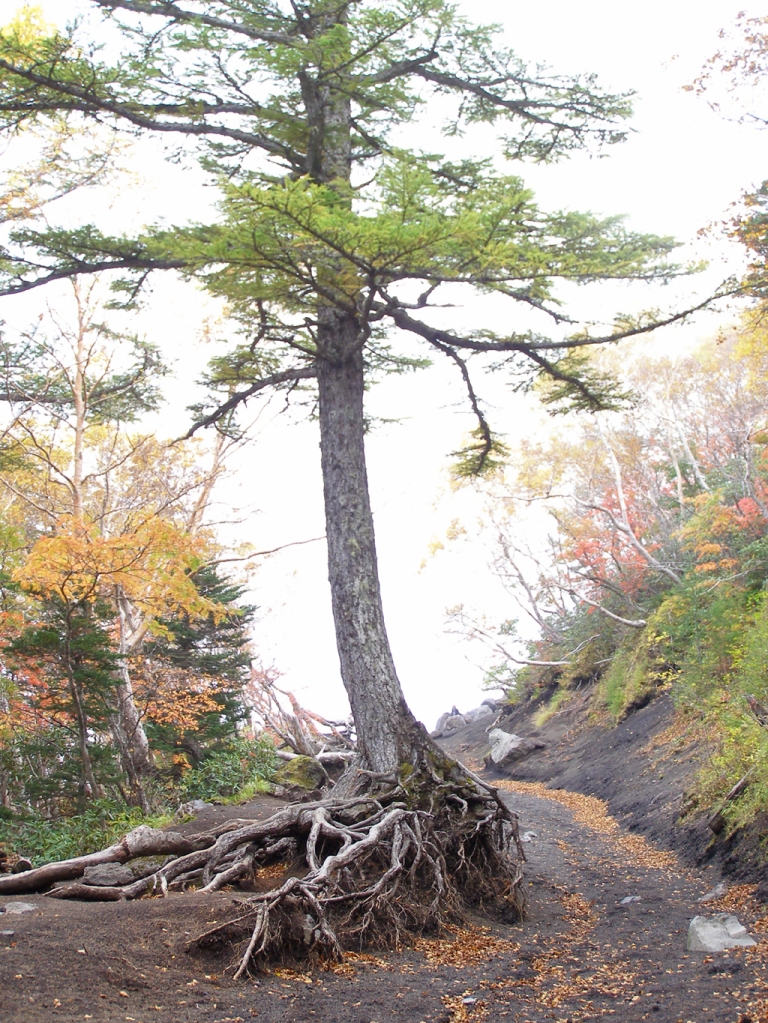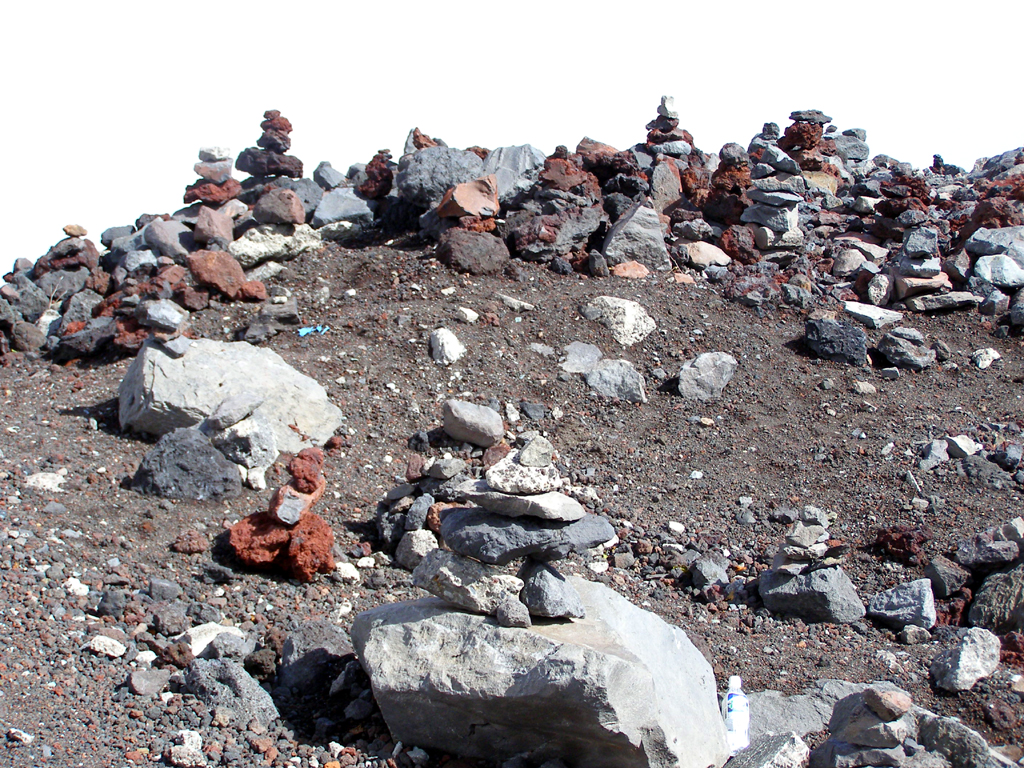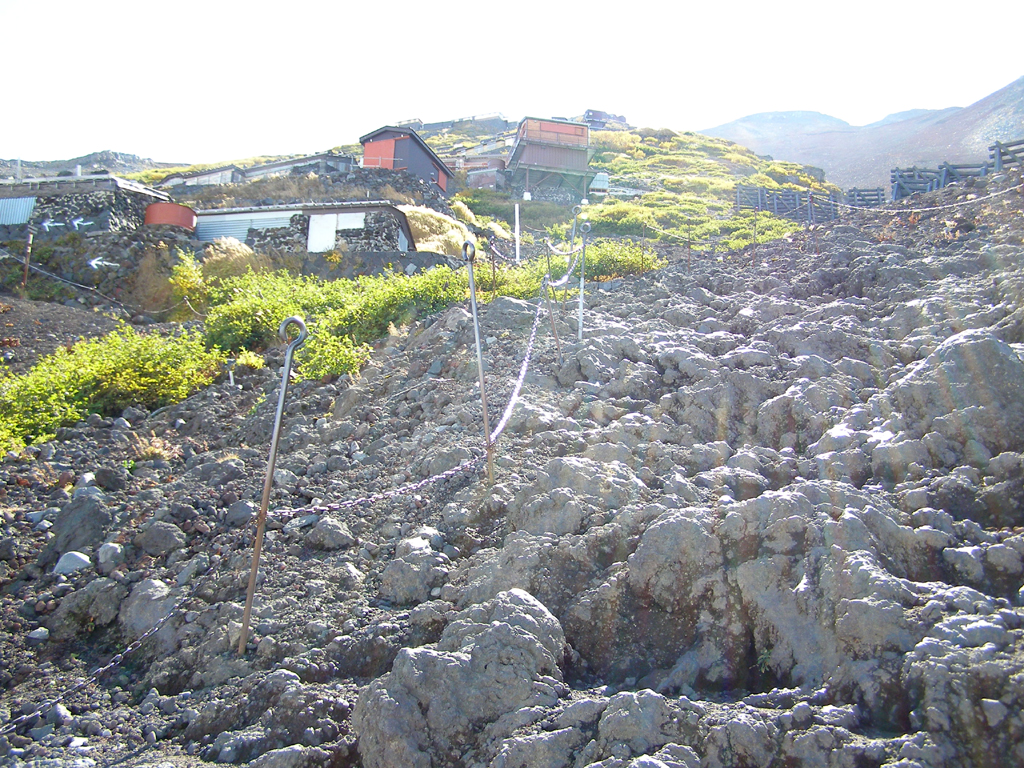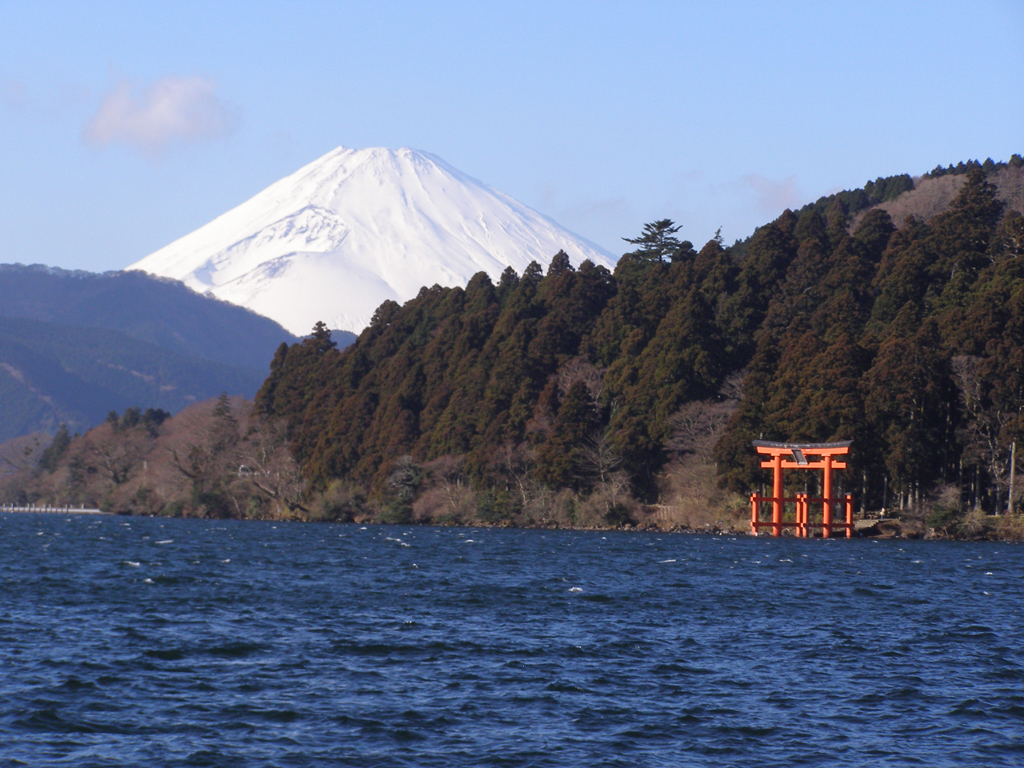The recommended way to climb Mount Fuji, or Fuji-san as it is called in Japan, is to begin at midnight in the summer months when the weather is less volatile and extreme. Hikers carry flashlights or don lighted headbands to illuminate the trail. The goal is to arrive at the top for sunrise, then descend early to avoid the heat of day or afternoon thunderstorms.
Hovering over the landscape, Japan’s highest mountain soars at 3,776 meters, or 12,388 feet, in altitude. The most popular trailhead starts at 2,300 meters, or 7,500 feet. And, as you have no doubt seen from photographs and those famous woodblock prints by Hokusai, the peak stands alone, rising dramatically in a classic shape.
In the fall of my second year in Japan, returning fresh from summer hikes in Colorado, where I lived at 8,500 feet, it made sense to me to hike Fuji-san in the fall, when I was already acclimated to high altitude air, rather than in summer, when I would have been living at sea level for months before.
I brushed off the warnings of my Japanese friend that Fuji-san should not be climbed in the fall because the danger of sudden snows made it unsafe. As a seasoned mountain hiker, I knew what was reasonable and checked the forecasts. Not eager to be stumbling around rocky paths in the dark, or biting off too much of a trek alone, I went for a day hike. These days, getting older and after decades of Colorado hikes, I was no longer feeling like I needed to get to the top of things. I came to commune with Fuji-san, not to conquer it.


The earliest train ride to Kawaguchi-ko, the town at the base, took about three and a half hours with several transfers, the bus up the mountain to the trailhead another fifty minutes. On the way there, the trains passed through mountain, village, and farmland, with hay tied in bundles and hanging out to dry on racks lined up in the fields. Ripening orange persimmon hung heavy from tree limbs. On this typical overcast gray day, Fuji-san was hidden from sight, even from the nearby villages. But during the ascending bus ride to the trailhead, through fog thick as cotton concealing the view as we rose, the clouds fell away like a shed skin as we broke through to a brilliant blue sky.
The clouds now gathered below me. Fuji-san’s brown bald pate, not yet blanketed in snow, appeared briefly through the trees as the bus rounded switchbacks to the Kawaguchi-ko fifth station, the highest stop accessible by road. There were ten stations, marked spots up the mountain. The Yoshida trail I had chosen started at the fifth station. The first was at the bottom, where the bus began, for those purists with plenty of time and energy; the tenth station was at the top. While I hiked, light clouds played hide-and-seek around Fuji-san’s peak, sometimes cloaking its shape, sometimes teasing and tickling, and at times shining white with reflected sun. The twisted tree forest, where the highest of the trees frequently braved ferocious winds, blazed yellow and red. Soon the trees disappeared and a chilly wind blew across the wide-open tundra.









In about two hours of hiking relentlessly uphill on a crushed lava path that narrowed to about sidewalk-width in long zigzags, I made it up to where the mountain huts began, where overnighters huddled before making the ascent to the top, or hikers could rest or escape the elements —just below the seventh station. I chatted with other hikers now and then and could gauge the time needed to go much further. A young man limped down the trail, leaning on another hiker he had met. Above that point, the trail changed to a rough, steep, rocky climb guided by ropes. From there, looking up, I could see the huts perched one above another on the intensely switchbacked trail. Looking down, a soft sea of clouds hid the world below treeline. A good place to consider a destination; the trek downward would get me there in time to catch one of the last buses of the day.



The clouds were rising, and I descended into fog on the way down. By the time I made it back to the bus stop, raindrops were pattering the ground and wind rustled the trees.


My thanks to The Travel Architect for asking about this hike!
This piece is an excerpt from my book, Go Wherever You Want (working title).
Please do not download or reproduce images from this site. ©
Your comments are welcome!
Popular posts/stats/categories
Email me at: Ruth@RuthRosenfeld.com

A beautiful hike in the fall, for sure, Ruth. We have been up to 5th station twice, but other than hikes at 5th station never went any higher. Thanks for sharing. Allan
LikeLiked by 2 people
I didn’t need to get to the top, but wanted to get the feel of the hike up there. Thank you for reading and your comment!
LikeLiked by 1 person
I love the notion of ‘communing with Fuji-san rather than conquering it’. Sounds like a wonderful experience, the views are certainly worth the hike. Love your photos of Fuji from Lake Ashi. Seems that you had perfect visibility. I wasn’t so lucky on my visit to Hakone. Thanks for sharing, Ruth. Have a wonderful day.
LikeLiked by 2 people
Thank you! It was a pretty gray day at Fuji, but I did luck out at Hakone several times. I don’t know if you saw the page in the reader or email – if you go to the actual page, there’s another photo at top from Hakone that has a torii. I’m just trying out the “featured photo” and find that it doesn’t show up in some places. I’ll have to add it to the page as well.
LikeLiked by 1 person
I read the article in the reader and saw the opening photo with the red torri. I’ve experienced this issue myself. There’s a certain version of WP that doesn’t show the cover photo. It might be mobile format?
LikeLiked by 1 person
I work on my laptop. I think it’s the email that doesn’t show it. I’ll keep experimenting!
LikeLike
I’d love to hike Mt. Fuji. Your pictures of the fall colours are beautiful.
LikeLiked by 1 person
Thanks so much! The fall colors in Japan are quite unique.
LikeLiked by 1 person
Beautiful photos!
LikeLike
Your photos are always gorgeous. Japan has been on my list of places to travel and reading your post just made me want to start planning. Love those leaves and their color.
LikeLiked by 2 people
Thanks so much for your kind comment. The fall in Japan is beautiful, as is spring with the cherry blossoms.
LikeLiked by 1 person
You are welcome!
I have seen photos of the cherry blossoms and hopefully when I go it will be during a time when they are blooming.
LikeLiked by 1 person
Wow… stunning views of Mt Fuji!!
LikeLiked by 1 person
Thank you, Jyothi!
LikeLiked by 1 person
Oh gosh, Ruth, the photos are so evocative of my vision of Japan and Mount Fuji. What an amazing experience.
LikeLiked by 3 people
Thanks so much, Kerry! Japan has so many treasures.
LikeLiked by 1 person
Thanks for sharing this beautiful hike on Mount Fuji.
LikeLiked by 1 person
I appreciate your coming along!
LikeLike
I’m guessing you’ve climbed Pikes Peak a time or two, Ruth (or another “fourteener” here in CO). Your description of the Mt. Fuji hike sounds very similar to America’s Mountain. Barr Trail starts at about 6,500′ on up to 14,000+. Refill your water supply at Barr Camp to survive those last couple of high-altitude miles that literally take your breath away. Somewhere along the trail lose the pine trees to a moonscape of rocks and scrub oak. Summit no later than noon in order to avoid lightning storms. Pikes Peak is less prominent on the Rocky Mountain skyline than Mt. Fuji in your beautiful photos but, IMHO, no less majestic. And of course, once you reach the top you have the option of a seat on the Cog Railway to escort you back to common ground!
LikeLiked by 3 people
No, I haven’t hiked Pikes Peak, Dave, but I’ve been to the top by car a few times. It sounds like a fun trail! We certainly have many notable peaks in Colorado. I have hiked parts of the Mt Evans trail and visited the mountain goat herd on top, and have hiked up a few biggies – Grays and Torreys, Bierstadt, (those are all in my neighborhood), Audubon, Hallett and Otis. It’s hard to beat Colorado for scenic mountain ranges.
LikeLiked by 1 person
I loved seeing your photos from the hike, with all the mists and autumn colours. We were fortunate to see Fuji-san, but not from Lake Ashi as you did – it had clouded over by the time we reached the lakeside. But we saw her earlier in the day, from the ropeway 🙂
LikeLiked by 2 people
Hakone has it’s own unique little journey. 🙂
LikeLiked by 1 person
This brings back such fond memories of when we visited Japan a few years ago. Unfortunately we didn’t have nearly enough time to see and do everything. I would love to return someday and do this hike. Looks beautiful.
LikeLiked by 2 people
I always think the same when I read the travel stories of others. You have to make decisions when traveling, time goes fast. It was wonderful to spend a few years there and not have to rush around.
LikeLiked by 1 person
This is a relate-able story and the photos are supreme.
LikeLiked by 2 people
Thanks for reading, Jay!
LikeLiked by 1 person
Looks like a beautiful hike. I only had the chance to see Mt Fuji from across the lake, but I was in the area during the fall as well. Amazing autumn colours.
LikeLiked by 2 people
It was, Jess. But of course you don’t get a view of the peak while you’re hiking! Autumn in Japan is so vivid.
LikeLiked by 1 person
Great read!
LikeLiked by 2 people
Thanks, Beth!
LikeLike
Beautiful prose. I’m glad you got to commune with Mt. Fuji. Thanks for sharing your adventure and thanks for the link!
LikeLiked by 2 people
My pleasure and thanks to you!
LikeLiked by 1 person
Beautiful. I missed the chance last year and again this year
LikeLiked by 2 people
Thank you for bringing me along the hike, I imagine I was there. I love the photos!
LikeLiked by 1 person
Thanks for coming along! So you didn’t make it to the top either?! 🙂
LikeLiked by 1 person
Breathtaking and beautiful. Dream Hiking Adventure.
LikeLiked by 1 person
Thanks for coming along, and taking the time to visit some of my past blogs.
LikeLiked by 1 person